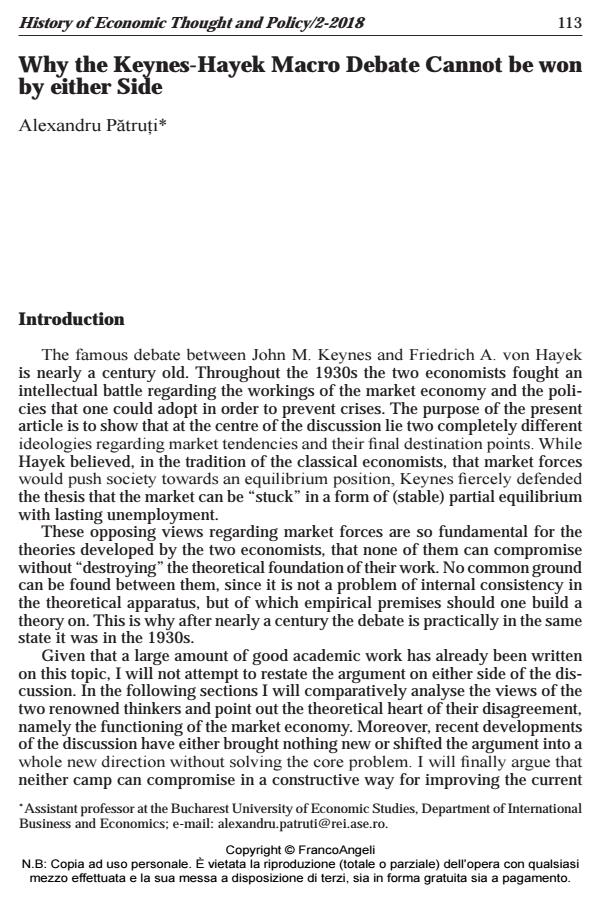Why the Keynes-Hayek Macro Debate Cannot be won by either Side
Titolo Rivista HISTORY OF ECONOMIC THOUGHT AND POLICY
Autori/Curatori Alexandru Patruti
Anno di pubblicazione 2019 Fascicolo 2018/2 Lingua Inglese
Numero pagine 13 P. 113-125 Dimensione file 181 KB
DOI 10.3280/SPE2018-002006
Il DOI è il codice a barre della proprietà intellettuale: per saperne di più
clicca qui
Qui sotto puoi vedere in anteprima la prima pagina di questo articolo.
Se questo articolo ti interessa, lo puoi acquistare (e scaricare in formato pdf) seguendo le facili indicazioni per acquistare il download credit. Acquista Download Credits per scaricare questo Articolo in formato PDF

FrancoAngeli è membro della Publishers International Linking Association, Inc (PILA)associazione indipendente e non profit per facilitare (attraverso i servizi tecnologici implementati da CrossRef.org) l’accesso degli studiosi ai contenuti digitali nelle pubblicazioni professionali e scientifiche
The controversy between Keynes and Hayek is one of the most renown in economics. Although it is now almost a century old, it does gather momentum from time to time, especially during periods of crisis when decision-makers are looking for policy solutions. However, in academic writings the actual debate did not and cannot find a common ground. I aim to show in the present article that at the center of the controversy is not a logical fallacy in the theoretical apparatus of either of the two economists, but the empirical premises which they took for granted. While Hayek believed that the market will tend towards equilibrium, and that real life conditions actually approximate this, Keynes considered that the market can be stuck in a partial equilibrium compatible with unemployment. I will further argue that subsequent developments attempt to move the debate in a whole new direction rather than solve this central issue.
Keywords:Equilibrium, market tendencies, J. M. Keynes, F. A. Hayek, market interest rate, unemployment
Jel codes:B13, B22, E20, E43, D50
- Facchini F. (2016). The Hayek-Keynes Macro Debate Continues, Journal des Économistes et des Études Humaines, 22(1):1-12.
- Ferlito C. (2015). Ludwig M. Lachmann Against the Cambridge School, Journal of Reviews on Global Economics, 4: 251-267. DOI: 10.6000/1929-7092.2015.04.25
- Hansson B. (1985). Keynes’s notion of equilibrium in the General Theory, Journal of Post Keynesian Economics, 7 (3): 332-341.
- Hayek F. A. (1945). The Use of Knowledge in Society, American Economic Review, XXXV(4): 519-30.
- Hayek F. A. (2008). Prices and Production and Other Works, Alabama, The Ludwig von Mises Institute.
- Hayek F. A. (2009). The Pure Theory of Capital, Alabama, The Ludwig von Mises Institute.
- Keynes J. M. (1930). A Treatise on Money (Vol. 1 The Pure Theory of Money), London, Macmillan.
- Keynes J. M. (1936). The General Theory of Employment, Interest and Money, London, Macmillan.
- Kirzner I. (1973). Competition and Entrepreneurship, Chicago, University of Chicago Press.
- Lachmann L. M. (1976). From Mises to Shackle: An Essay, Journal of Economic Literature, 14(1): 54-62.
- Lachmann L. M. (1979). On the Recent Controversy Concerning Equilibration, Austrian Economics Newsletter, 2(2): 6-7.
- Lachmann L. M. (1994). Austrian Economics under Fire: The Hayek-Sraffa Duel in Retrospect, In Lavoie D. (ed.) Expectations and the Meaning of Institutions, London and New York, Routledge: 141-157.
- Magliulo A. (2016). Hayek and the Great Depression of 1929: Did he really change his mind?, The European Journal of the History of Economic Thought, 23(1): 31-58. DOI: 10.1080/09672567.2013.792373
- Mittermaier K. H. (1992). Ludwig Lachmann (1906–1990) A biographical sketch, South African Journal of Economics, 60(1): 4-12.
- Ahiakpor J. C. (2009). The phillips curve analysis: An illustration of the classical forced-saving doctrine, Journal Of The History Of Economic Thought, 31(2): 143-160. DOI: 10.1017/S105383720909016
- Blaug M. (1992). The methodology of economics or how economist explain, Cambridge, Cambridge University Press, 2nd ed.
- Caldwell B. (1995). Contra Keynes and Cambridge, Indianapolis, Liberty Fund.
- Rizzo M. J. (1990). Hayek’s Four Tendencies Toward Equilibrium, Cultural Dynamics, 3(1): 12-31.
- Shenoy S. R. (2009). A Tiger by the Tail: The Keynesian Legacy of Inflation, Alabama: Ludwig von Mises Institute.
- Wicksell K. (1989). Interest and Prices, New York: Sentry Press.
- Keynes and Hayek: some common elements in business cycle theory ALEXANDRU PĂTRUŢI, in Brazilian Journal of Political Economy /2023 pp.48
DOI: 10.1590/0101-31572023-3375
Alexandru Patruti, Why the Keynes-Hayek Macro Debate Cannot be won by either Side in "HISTORY OF ECONOMIC THOUGHT AND POLICY" 2/2018, pp 113-125, DOI: 10.3280/SPE2018-002006